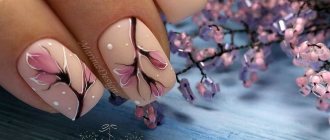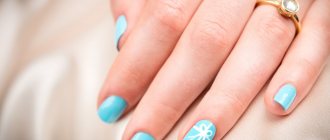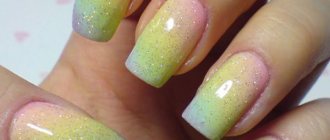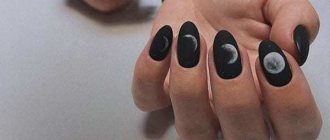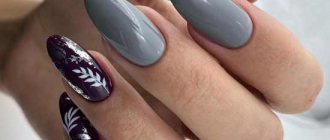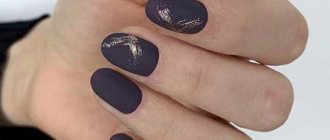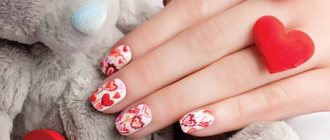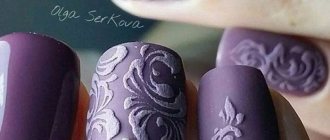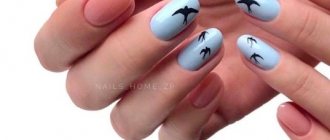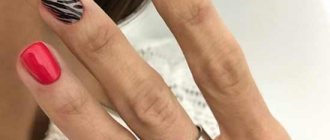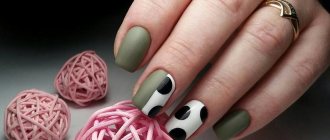Hello, dear readers! If you want to do something new and unusual with your nails, try an Indian style manicure. Ethnic design options in modern nail art are always popular, which is not surprising - such a manicure always emphasizes individuality, as it looks unconventional, stylish and a little bewitching.
What is mehendi
Mehendi or mehndi (eng. mehndi) is an original body painting technique, known in Eastern countries since ancient times. Originating in Ancient Egypt, the art of decorating the body with patterns has been supplemented and modified over the centuries by the peoples of India, North Africa, Mesopotamia, Malaysia, and Indonesia.
In recent decades, artists from European and American countries have made their contribution to the development of mehndi.
This eastern trend manifested itself especially clearly in Western culture in the 60s of the last century - then paisley patterns and other floral elements in the mehndi style were especially popular. They were widely used in clothing and various accessories.
Currently, body painting masters create their original compositions based on the classics of this style, thanks to which mehndi continues to develop and does not lose its popularity around the world.
In the East, it is generally accepted that mehndi not only decorates the body, but also serves as a kind of amulet against evil spirits, and also attracts good luck and prosperity. In India, Malaysia and a number of other countries, henna painting is almost a mandatory ritual for women before a wedding or other special ceremonies.
Of course, such a significant artistic phenomenon as mehendi could not be ignored by modern nail art. Many women do manicures in ethnic style. Indian motifs on nails remain trendy in the 2022 season and will probably not go out of style in the coming decades.
Indian manicure
Of course, Indian manicure or Indian pedicure is unlikely to take root in Moscow. But something can and should be taken from there. Indians love to experiment with color. They love different colors. Red, yellow, orange, green, gold, white.
Researchers examine in detail the medical, physiological and emotional aspects of color. Green - calms, relieves pain, balances. In India it symbolizes peace and hope, for Muslims green is a guardian against the evil eye, and in China it is a symbol of a luxurious life. Green is the color of hope; it, like no other, relieves eye fatigue. They say that people who love this color are demanding of themselves and others, but at the same time they are tolerant and have artistic abilities. Indians draw beautifully, both men and women.
Orange is cheerful, creates a feeling of well-being. Orange, like red, is a warm color, but lacks the aggressiveness of red. Cheerful, causes joy, enhances activity. Blue - antiseptic, effective for neuralgic pain and inflammation. We love you in Egypt, in the Muslim world. In India it is a symbol of truthfulness.
Yellow in India is a symbol of splendor, in Russia it is a sign of separation, in Brazil it is a symbol of despair. Yellow color is sunny, cheerful, evoking a feeling of joy.
Red is warm and irritating, stimulates the brain, a symbol of danger and prohibition. We love people who are amorous and emotional. In China, for example, the color of the holiday is good luck; In India - the color of life. Creates a desire to act and make efforts. Stimulates a good mood. Purple in India symbolizes sadness and comfort.
The color purple is especially loved by women with a rich and unusual inner world. It suits both delicate light skin tones and dark, olive skin tones. Attracts and repels in equal measure, full of life, but in some cases causes sadness. White is the color of purity, in Europe it is a symbol of youth.
Pink - effective for melancholy. Young Indian women love pink very much. The color is very feminine, and all its shades are loved by both blondes and brunettes.
I bought myself a sari on the advice of an Indian girl in a sunny yellow color with light green transitions on the fabric, decorated with silver rhinestones and silver thread.
Style Features
The most important thing for a mehendi style manicure is symmetry and equal thickness, mostly thin lines. It is difficult to depict large-scale patterns on nails, so masters mainly use the simplest elements of ethnic Indian design: paisley patterns, flowers, trees, star combinations.
As a complement to the main pattern, lines of dots or small circles and other small details are often added.
Another important feature of Indian style manicure is the required color contrast between the base coat and the painting. The most popular colors for the background are beige, white, green, as well as any pastel shades. But of course you can use a variety of colors - there are no specific frames here.
Note: Coming up with a mehendi pattern on your own is not easy, especially for beginners. Therefore, the easiest way is to redraw fragments of your design from available sources - even experienced manicurists do not hesitate to admit that in their works they do not invent ethnic patterns themselves, but copy them, making only their own small additions and changes.
Nail design in oriental style
To design nails in an oriental style, you need to comply with 2 conditions - harmony, luxury, precision.
Oriental designs on nails
Most often, to decorate nails in an oriental style, natural patterns and graphics are used, various patterns are depicted, highlighting them with gold and rhinestones. Imitation of Arabic script looks very impressive in combination with contrasting colored foil or matting.
Islimi and girikh are also used. The first is a floral ornament with elements of intricate vines, monograms and flowers. The second is geometric shapes made of nodes, lines, and meshes. Most often, one type of pattern is complemented by another, which makes it possible to create various luxurious combinations.
The meaning of oriental patterns
Each pattern, made in the traditions of the East, carries a certain meaning. Since Islam prohibits depicting humans and animals, only the plant and geometric versions remain. But to create the style itself, the scope of the ban is expanded a little. So, here you can depict a stylized peacock feather, which symbolizes good luck and protects from evil people.
In the arsenal of beauties you can find symbols of the sun and moon, which speak of happiness and secrets, paisley cucumbers, which serve as a symbol of approaching God, stars connecting the top to the bottom. Various ornaments and figures protect against the evil eye, evil, and poverty. Thus, the symbolism of Arabic manicure is purely spiritual in nature.
Suitable colors for Arabic manicure
The favorite colors of Eastern girls are the natural shades of nature found in precious stones and metals. This is the color of the sky, foliage, burgundy or carmine red wine, the shine of oriental sweets. It is the harmonious combination of natural shades that allows you to create the luxury of Arabic nail art, but at the same time avoid flashy vulgarity.
Turquoise
Blue, greenish, azure shades add tenderness and lightness to the image. This look goes well with white, beige, gold and rhinestones.
The most delicate nail design in the oriental style, the photo of which is presented below, is made in shades of the sky and emphasized with gold.
Emerald
Emerald and light green shades are usually combined with white, black, and gold. Sometimes they create a monochrome version, where they use stones or other decorations in the same color scheme, but with different textures.
Sapphire
Any shade can be combined with sapphire. As additions, you can use gold, silver, rhinestones of the same or contrasting color. This is a universal color for creating different designs based on the mysterious East.
Ruby
The color of the gemstone is highly valued in the East, so Arabic manicure in ruby tones is usually done for special occasions. By itself, ruby does not require any additions. However, it goes well with matte or shiny gold, rhinestones, beads, and stones.
Bordeaux
A shade close to ruby, but warmer. Reminds me of a well-aged red wine. And the older the wine, the more expensive it is. Bordeaux looks luxurious and expensive, especially in the combination of stones and gold ornaments. The most common design in the oriental style is shown in the photo below in all its glory.
Gold
One of the signs of oriental manicure is gold. You can cover every nail with gold, or you can cover just one.
Gold can be present in the form of a thin strip as an accent, or it can be the leading decoration. Gold voluminous monograms, symbols, sparkles and stones give a rich luxurious look, which is the main condition in the oriental style.
Important! Neon, unnatural, faded tones are not used in oriental manicure.
Oriental nail design with rhinestones
Decorating nails with rhinestones is one of the most common options for Arabic nail art. It is beautiful, effective, and looks expensive. For an everyday option, stones are usually placed on 1-2 nails, creating accents and emphasizing originality. The festive version traditionally allows you to completely cover the nail with rhinestones, while the everyday version requires more restraint. The Arabic manicure, the photo of which is presented below, is made in the best traditions of the East.
Manicure with feathers
Arabian manicure with feathers can be bright and graphic, as well as delicate or powdery. To create it, both ready-made drawings and real feathers are used, which are placed under a layer of transparent gel. Real masters of their craft can create a natural picture on their nails using special paints and a thin brush.
Artistic Arabic manicure
This is the most labor-intensive type of Arabic manicure, performed manually. Every curl, every line, every point is done with a thin brush. One of the important points is correctly selected shades and accents. Bordeaux or turquoise with gold, emerald and green stones, there are few combination options, but knowing the laws of oriental style, you can create an outstanding masterpiece.
Methods of execution
Indian style manicure can be done in four main ways:
- using stickers;
- using stamping;
- drawing patterns through stencils;
- drawing by hand with a thin brush.
The first three methods are simple and do not require any special preparation - we prepare the nails, apply a base, then a base coat of gel polish, stamp the design on the desired fingers and cover it with a top coat.
We will dwell in detail only on the fourth method. It allows you to create a truly original design that emphasizes your individuality. Many amateurs, having mastered the technique of painting on nails and using the most modern nail art technologies, create real masterpieces on their nails!
Of course, for many, drawing neat thin lines is quite difficult and the best option would be to turn to a professional master. But if you want to learn how to create original and stylish patterns on your nails with a brush, you will have to spend a fair amount of time on training - you cannot do this without experience.
How to draw
The first and most important thing is that the brush should have a thin tip.
As for the length of the pile, it doesn’t matter what you like. Typically, it is more convenient to outline the future design with a long-bristled brush, and to draw the smallest details of the pattern, it is more practical to use a short-bristled brush. Also, many craftsmen use a long-haired liner brush for such patterns, which is ideal for creating geometric patterns.
You can paint with either gel polish or gel paint - in this case there is not much difference. If you need the thinnest possible lines, then it is better to paint with gel polish with good pigmentation. And if you draw with fairly voluminous lines, it is better to use art paste or gel paint without a sticky layer.
How to draw
- First, you need to learn how to properly put material on your brush. It is convenient to use foil or something similar as a training palette. Before use, wipe the brush with a lint-free cloth soaked in de-sticking liquid. You should definitely have such a napkin on hand to wipe your brush from time to time.
- The brush must be completely soaked in gel polish or gel paint. To do this, drag the brush across the palette while scrolling it. As a result of this simple manipulation, you will do three things at once: saturate the brush, remove excess material from it and form a thin tip.
- There should be no droplets on the tip of the brush! If you watch how much material you put on the brush, then the lines without any additional effort will turn out to be approximately equally thin along the entire length. To check whether there is too much paint on the brush, you can draw several test lines on the palette.
- When working, it is advisable to have a support for your hand, especially if you have very little experience.
- Hold the brush almost perpendicular to the nail surface. This is not very convenient for beginners, but if you want to learn how to draw beautiful patterns, you need to practice holding the brush correctly.
- You should try to draw lines with the tip of the brush. And if you need a thicker line, you can press the brush a little and stretch it across the surface.
These recommendations can be fully applied not only to Indian-style manicure, but also to drawing any other subtle patterns on nails, for example, when creating a “dream catcher” manicure.
Traditions of using mehendi
The mehendi culture appeared more than 5 thousand years ago. Oriental style designs were made with henna on the hands and body.
Mehendi was used as an everyday body decoration, which was made with simple patterns. There was also a festive version, which was performed with special care.
In different eastern cultures, special significance is attached to mehendi:
- In the Middle East, plant motifs are popular - a symbol of prosperity and life. Bedouins simply dipped their hands and feet in henna, giving a special color to the skin;
- In India, they prefer designs that symbolize fertility and religious motives. Therefore, lace painting is used to decorate a girl’s body for a wedding or major holidays;
- the peoples of Malaysia traditionally draw patterns on the bride’s body;
- In Indonesia there is a custom of painting the pads of the fingers and feet.
From a sacred image to a decorative one, today it is used as a temporary tattoo outside the East: in Europe and America.
Unlike stickers or transfer tattoos, henna does not tighten the skin and lasts up to 3 weeks. It is produced all over the world.
It is recommended to use hypoallergenic red henna. A special dye is added to black, which can cause contact dermatitis.
Advice from the master
Of course, before drawing mehendi on your nails, it is best to practice on tips or on a regular sheet of paper. Only in practice can you understand how thin lines are obtained and how wider ones are obtained. During training, it is advisable to try to draw lines in different directions, including directions that are uncomfortable for you.
And most importantly, concentrate your attention on each line and do not forget about what you are drawing. If you relax and do everything automatically, there will be practically no benefit from training. In order to draw thin lines clearly and quickly in the future, you first need to learn how to carefully draw each one.
How long should you train? Nobody will tell you this. For some, a few hours will be enough, while for others it will take more than one week. It all depends on your desire to learn, and of course on your abilities. And then - there is no limit to perfection. The highest level of skill is achieved by those who understand this and continue to train daily, already being an experienced master.
Design selection
Even a simple Indian style nail design looks very stylish.
For example, black mehendi lines look great on a surface made in pastel colors.
This combination of colors is considered classic - it seems to imitate regular mehndi henna patterns on the skin. It is also worth noting that Indian-style patterns look most impressive under a matte finish.
And of course, it is not at all necessary to decorate all your fingers with patterns. Sometimes, to create a stylish design, it will be enough to paint one nail.
If you draw mehendi yourself with a brush, try not to copy patterns from a photo or entire picture, and redraw only its individual fragments. And fantasize more! This way you can create your own original Indian style manicure design.
How to do a manicure in India and what is the technology for doing it
Manicurists in India do manicures in almost the same way as in Moscow: first disinfection, then the cuticle is removed, then the nails are shaped. Next, the process differs from what we are used to, and this is the color scheme of the design. The coating of Indian women's nails is characterized by a bright and rich shade of varnish.
Here it is customary to carry out the design using undried varnish. This is the so-called drip method, that is, stretch marks are made with a brush from one color to another. The result is very beautiful. But regarding the classic trimmed manicure and pedicure in India, the conversation is separate.
It turns out that the best classic trimmed manicure and pedicure comes not from experienced professionals, but from “gara rufa” fish. It is they who consider keratinized skin the best dish on their “table”, and therefore, as soon as the client dips her hands or feet in warm water, the gara rufa immediately gets down to business.
Brief summary
Indian style manicure is one of the most original and stylish trends in modern nail art.
In order for a mehendi design to look impressive and look like a solid, complete composition, it must be done very carefully, almost flawlessly.
If you make mehendi patterns on your nails with a brush, do not forget that the main thing in such work is experience. Don’t be lazy to practice using tips every day and in a month or two you will be able to draw with thin lines easily and freely.
Once upon a time, the creators of mehendi painting put some special meaning into the symbolism of their patterns. Of course, we are unlikely to be able to convey it by copying fragments of ancient symbols. But it's not that important. Such a manicure radiates positive vibes, makes us more feminine, mysterious and attractive - and this is quite a lot.
What do you think about mehendi style nail art and other ethnic nail designs? Share your opinion in the comments!
